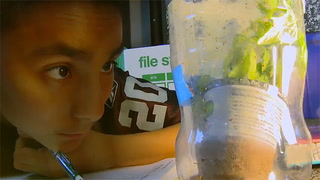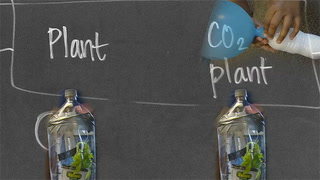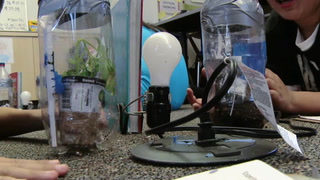Classroom Close Up: Climate Change in a Bottle - The Lesson
With Suney Park
[01:00:11;09]
Suney: "You guys know that for the past how many weeks, now, have we been studying climate change?"
Student: "Like for a month."
Suney: "Like for a month."
In terms of making science relevant, one of the big topics now, the big concerns is climate change. Um, it's um, and so we decided to embrace that.
"OK, so we did 'What is global warming?' What was our second chunk of notes that we took?"
Students: "Energy sources"
Suney: "Energy sources. Where do their energy sources come from? The third one was? Maiah?"
Student: "I think natural cause."
Suney: "What are the natural causes of climate change, and what was our fourth chunk, Cynthia?"
Student: "Human causes?"
Suney: "The human causes of global warming, and climate change, and..."
I was discouraged at first, thinking it was too complex, too hard for sixth grade.
"What are some of the impacts and effects?"
But, anything that can be broken down to the basics can be taught.
"And Rayna?"
Student: "Future impacts."
Suney: "Future impacts, we're studying that."
So what I do is at the beginning I say 'You know what? College students are learning about this, high school students, and scientists who are, you know, a lot older than you. This is what they're doing, but I'm gonna challenge you to do it' And, they all want to. They're like 'Bring it on!'
"The next one is gonna be what, starts with an 'S'"
Students: "Solutions?"
Suney: "Solutions."
And so I know that there's portions that they can understand, and I think that this experiment was right on target for what they would be able to comprehend.
"Why is the greenhouse effect important, and what does it have to do with climate change? Roberto?"
Student: "Like, if CO2, well, the main question is will temperature change if carbon dioxide is added to the atmosphere?"
Suney: "Excellent."
The beginning of the lesson, before doing the experiment, we do a background first to show them what connection this experiment made with what we've already learned.
"And who wants to give us a little connection about what on earth does that have to do with the greenhouse? DeMaurier?"
Student: "The reason why it's called the greenhouse effect is because um, in like, the greenhouse, like will trap the um, the, the air, or like the carbon dioxide, and it'll like, um, be trapped, and um, it'll create like, heat and humidity for the plants to grow."
Suney: I tell them all the time that science, you know, it's not hard. So, I wanted the students to design an experiment themselves that would parallel what they've been reading about climate change. So, in my head, I wanted them to come up with things that were reasonable, that can be done, and that can be measured, but I wanted them to use also, what they've been learning in um, climate change.
"So, the first experiment we wanted to try was we wanted to see do greenhouse gases really make the temperature rise?"
So what we did was, the first day, all I did was introduce the sys..the whole um, concept of making a model.
"If we were to make a model of the greenhouse effect actually happening, then I could take one of these things..."
All I did was show them a soda bottle and I said 'How can we re-create the earth and its atmosphere in this model?'
"I could test it out by look, by doing something to this model."
And then they told me what to add to it.
"So you guys said, 'why don't we add some um, carbon dioxide to one of the bottles, and see what difference it has with the other one. True?'"
Students: "Yes."
Suney: "OK"
So they designed each of the four experiments.
"So we came up with four experiments to do, and you guys came up with this yourself."
They were specifically setting up different systems; different models of the earth, adding different variables to what would be the atmosphere.
"If the control was simply a closed um, bottle, with some earth in it, and we're gonna put some earth in it when you guys setup. And, if that's all it is, what was the first thing that you guys decided to test. Vanessa?"
Student: "Carbon dioxide"
Suney: There were four experiments going on. One was a control, the two-liter bottle with soil in it, no added greenhouse gases, that was compared to the regular earth with an extra load of carbon dioxide.
"Raise your hand if this one's your experiment. Could you tell us what you put down as your driving question? And, everyone else, you're gonna look at your worksheet, the yellow one, that says Driving Question, Hypothesis, and Diagram."
Another important part is to have this driving question, where at the end you're gonna have an answer to that question.
"So, somebody from that group, could you tell us what you said was the driving question of your experiment?"
And so I wanted them to kind of figure out for themselves that temperature change should be the one thing that we're looking for. Cynthia?"
Student: "Does more CO2 than the regular atmosphere affect the temperature?"
Suney: "Does more, you guys should be writing this down, does more CO2, keep going."
Student: "Does more CO2 than the regular atmosphere affect the temperature?"
Suney: And so the driving question was really important, and it was also important to have each of the groups share out loud, and that way everybody knows what the purpose was for each of the four, different experiments.
All: "Does more CO2 than the regular atmosphere effect the temperature?"
Suney: "OK. Can you tell me what your group expects to happen? What do you expect the temperature to be in the bottle with extra CO2, and the one without extra? What is your hypothesis?"
So, hypothesis, you know, is part of the scientific inquiry process. I'm asking each student to share out what their hypothesis is.
Student: "My hypothesis is is that the bottle with the CO2 is going to be hotter because um, like, the carbon dioxide, it like, in the real world, it like, reflects back down, and makes um, it hotter. And, that's what global warming is. So, I think that the bottle with the CO2 is going to be hotter."
Suney: "OK. Perfect. So, right now, in your own words, write down your hypothesis. OK?"
I also want to give the students a chance to write in their own words because then it's what they're thinking, and so I give them a quiet moment to reflect. And, now it's recorded so now you can make your comparison at the end.
"OK, how about group 2? What was the next, um, experiment that you guys designed?"
The second experiment, we introduced the plant.
Student: "For our driving question, we did um, how do the plants affect the temperature?"
Suney: "Yes. What should it look like? Go for it TreSean!"
Student: "Um, they both will have soil."
Suney: "OK, they're both gonna have soil because we want everything to be the same."
Student: "Um, both of them will have a thermometer."
Suney: "OK, they're gonna both have a thermometer."
Student: "And, one of them's gonna have a plant."
Suney: "One will have a plant."
The third one was, we added carbon dioxide to both.
"Put extra CO2, extra CO2 here, and a plant. Driving question? Jonathan."
Student: "Um, how does CO2 affect temperature, with or without a plant?"
Suney: "Perfect."
And then the final one...
Student: "How does a plant affect temperature, with or without CO2?"
Suney: "Alright. Scientists, once you have that, you can put that yellow sheet to the side, and put your pencils to the side, um, and we're gonna get setup for the experiment. Right now, is a very, very critical time. Sit up straight. In just about five minutes, you are going to be independent to setup your systems. OK? So, watch, listen, and learn."
As a teacher, because my students designed the experiment themselves, it makes me feel like you're giving them a skill by which to be successful in life, that they're not gonna be someone who's told what to do, that they're not gonna be somebody who doesn't contribute, and just kind of falls to the side and let other people do the, the important things. I want my students to be the ones on the field, playing. I want what they do to matter, and I want them to know that they have the ability to do that and so, sitting back and just learning what other people wrote in a book is not OK. I want them to be the creators of what they're learning.














9 Comments
Toktam Ceballos Nov 11, 2020 10:29am
I like how the teache will make students ready for expriment I belive critical thinking is most important for our students
Kimberly Lair May 19, 2020 10:57am
I like the way Ms. Parks takes the time to help her students make connections to what they have learned and how they might use it in the future. I also thought it was sweet that 6th graders are the same regardless of where you live. When her students began to get frustrated because the temperature did not rise fast enough, it reminded me of my students. It's great that she is helping her student learn in a concrete way that some things you just can't rush.
Kimberly Lair May 19, 2020 10:48am
Ms. Parks is very effective in helping her students understand that an experiment has parts. She points out that it is difficult for 6th graders to take the experiment all in at once. It is important to have everything ready before the students come in and to have a place in the room for each type of material.
Sherry Thomas Sep 16, 2017 11:07pm
Lynne Gayler Jan 2, 2017 9:55pm